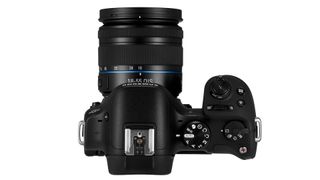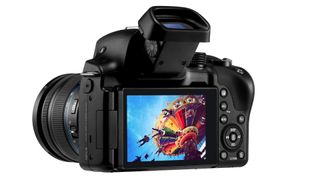Why you can trust TechRadar
Samsung compact system cameras are generally divided into two camps. There's the flatter, more compact-camera-like style, and then there's the thicker, DSLR-like devices, and that's the category the NX30 falls into.
There's a chunky grip, which is textured and feels very nice to hold. There's a ridge on the grip for your middle finger to sit on and feel extra comfortable, and also a raised thumbrest on the back of the camera, so the camera sits very nicely in the hand. It's probably not a camera you'll use one handed all that often, but if you did want to, it feels secure.

Although the NX30 has a touchscreen, unlike the Samsung Galaxy NX, there are lots of physical buttons too, which will likely be appreciated by more traditional users. It's nice to be able to use a combination of the touchscreen and real buttons to quickly change settings, too.
On top of the camera are quite a few dials and buttons. There's a mode dial for switching between the various exposure options, including fully automatic and semi-automatic modes such as shutter priority and aperture priority. Wi-Fi has its own slot on the mode dial since you can do quite a few different things with the Wi-Fi options – I'll come onto that later. There are also two slots for groups of custom settings – useful if you often find yourself shooting a particular type of scenario (such as low light).

To the right of the mode dial is a smaller dial for changing the drive mode, a simple flick can move you from single shooting to burst mode, time or bracket mode. It's a nice addition which saves diving into the menu to change the setting, and the dial is stiff enough to not accidentally be knocked out of the position you desire.
Around the shutter release button is the on/off switch, while just behind it is a scrolling dial used for altering aperture or shutter speed, depending on the mode you're shooting in. If you prefer, you can also use the dial on the back of the camera to make this change, and if you're shooting in fully manual mode, you use one for shutter speed, and the other for aperture.
To the right of the shutter release is a small button for changing the metering mode and another for accessing the Wi-Fi functions of the camera.
There are also quite a few buttons on the rear of the camera, and they're all grouped on the right-hand side of the body for easy access from the thumb. There's a traditional four-way navigational pad, with each direction of the pad serving a specific purpose – right changes the AF mode, up changes the display, down changes the ISO (sensitivity) and left changes the white balance. Unlike with Sony cameras, there's no way to change the purpose of the buttons on the back of the camera, but it's a sensible choice of options nonetheless. There is one custom button, which doubles up as the delete button, which can be set to one of three settings – Drive Settings, AF Area or Reset. It would have been nice if you could have set a wider variety of settings here.

The Fn (function) button gives access to the most commonly used settings. Pressing this button brings up a display which you can navigate around using the directional keys, or you can touch the screen itself. You'll find options including AF area mode, aperture and sensitivity.
Other buttons on the rear of the camera are an exposure compensation button, AEL lock button and a playback button. Exposure compensation is altered by holding down the dedicated button and then using the dial on the top of the camera to add or reduce compensation.
To change the autofocus point, you have a couple of options. You can press the central button on the navigation pad and then use the navigational keys to move around to the point you require, or you can use the touchscreen to quickly tap the point you require. One problem here comes when you're using the EVF as it can be quite easy for your nose to change the AF point, presumably in the brief pause between the EVF switching on and the LCD switching off. Eventually, you learn to approach the EVF in a different way (forehead first), but it takes a bit of getting used to. If you're finding it particularly problematic, you could switch touch AF off, or fold the screen inwards towards the body of the camera.
Another useful feature here is that you can set the autofocus point, then drag across the screen the corner of the box to another point to set exposure lock to a different point on the screen. When you're done, you simply drag the second box back into the AF point box to rejoin them.

The fully articulating screen sits flush against the camera body, thanks to a recess into which the screen can be folded to protect it when not in use. The screen's hinge feels very secure and like it could withstand a fair amount. An articulating screen is the most useful in terms of shooting both landscape and portrait images, along with self-portraits.
Another clever piece of design is the viewfinder. Not only is there a sensor for automatically detecting when it's lifted to the eye for an almost seamless transition between using the LCD and the EVF, but it also pops out to tilt through various degrees to all the way upwards. Thanks to the clever, sleek, construction, you might never realise it did this, but it does and it's very useful if you're shooting something from a slightly awkward angle.
Samsung's Wi-Fi functionality is excellent, allowing you to instantly upload images to Facebook and the like, as well as take remote control of the camera. It's a lot more flexible than some of the other manufacturer's options, and we often wish that other companies would adopt the same approach to Wi-Fi integration as Samsung.
Amy has been writing about cameras, photography and associated tech since 2009. Amy was once part of the photography testing team for Future Publishing working across TechRadar, Digital Camera, PhotoPlus, N Photo and Photography Week. For her photography, she has won awards and has been exhibited. She often partakes in unusual projects - including one intense year where she used a different camera every single day. Amy is currently the Features Editor at Amateur Photographer magazine, and in her increasingly little spare time works across a number of high-profile publications including Wired, Stuff, Digital Camera World, Expert Reviews, and just a little off-tangent, PetsRadar.


